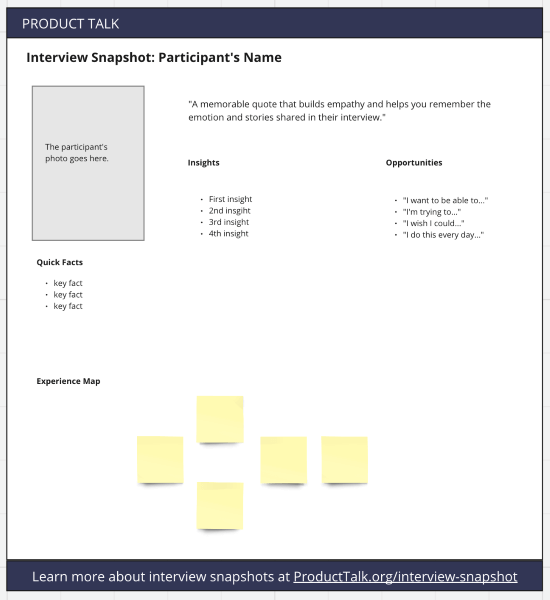When you start interviewing customers every week, it’s easy to get overwhelmed by how much you are learning.
When we use our customer interviews to collect specific stories about past behavior, every conversation can uncover dozens of unmet customer needs, pain points, and desires (AKA opportunities).
I recommend teams use three different artifacts to keep track of what they are learning from their customer interviews:
- The interview snapshot: This artifact summarizes what you learned from a single customer interview. Teams should create an interview snapshot for each interview that they conduct.
- A comprehensive experience map: This map represents the experience of multiple customers. It’s an amalgamation of all the individual experience maps that appear on your interview snapshots.
- An opportunity solution tree: This artifact captures any opportunities from across your interview snapshots that are relevant to your current product outcome.
These three artifacts represent different levels of synthesis and analysis—each helping you accomplish different goals. The interview snapshot helps you capture everything you heard in a single customer interview, the comprehensive experience map helps you understand the experience of your customers across your customer base, and an opportunity solution tree helps you find the best path to your desired outcome.
The interview snapshot summarizes what you learned from a single customer interview. Teams should create an interview snapshot for each interview that they conduct. – Tweet This
Today, we are going to do a deep dive on the interview snapshot.
What Is an Interview Snapshot?
An interview snapshot is a one-page template that helps you quickly capture what you learned from a single interview. When teams create interview snapshots for every interview they conduct, interviews become more memorable, actionable, and reference-able.
When teams create interview snapshots for every interview they conduct, interviews become more memorable, actionable, and reference-able. – Tweet This
When teams gain experience with interview snapshots, they can create one collaboratively in as little as 15–20 minutes. However, it can take more time than that when you are still learning how to use them.
Ideally, the team would create an interview snapshot immediately after the interview while the stories are still fresh. For example, you might book a 45-minute time slot on everyone’s calendars, spend the first 20–30 minutes interviewing the customer, and the final 15–25 minutes creating the snapshot.
Breaking Down the Interview Snapshot: Section by Section
An interview snapshot is comprised of the following elements:
- The name of the interview participant
- A photo of the interview participant
- Some quick facts about the interview participant
- A memorable quote from the interview
- A list of opportunities that you heard in the interview
- A list of insights from the interview
- An experience map that reflects the story that you collected in the interview
Name, Photo, & Quick Facts
The name and photo help you quickly identify and remember who you interviewed. The “Quick Facts” section is where you want to capture key details about the participant. Which details you capture will vary from company to company or even product to product, but the goal is to help you put the conversation into context.
For example, here are the quick facts I captured during a recent interview:
- Role: Product Manager
- Product trio: Yes
- Tasked with outputs or outcomes: Outcomes
- Organizational context: B2B Enterprise
- Product Talk History: 2 Deep Dives, subscriber since 2018
- Habit maturity: Interviewing, no assumption tests
These quick facts help me quickly understand the context for what I learned in the interview. They also allow me to later organize opportunities and insights by different segments if I need to.
The Memorable Quote
The purpose of the memorable quote is to help you recall the story days, weeks, or even months later. I remember memorable quotes from interviews I collected years ago. When I recall them, they bring me right back to the interview story.
For example, I remember one product manager saying, “I’ve worked here for three years, but they feel like dog years.” This interview happened in 2016 or 2017. But off the top of my head, I can still tell you who said it, where we were sitting, and the broader context of the conversation. That’s the magic of a memorable quote.
When a participant expresses strong emotion, as in the example above, that’s usually a good candidate for a memorable quote. But sometimes the memorable quote can just represent something unique about the story. For example, if a participant does something surprising, has a quirky workflow, uses the product in an unexpected way, or otherwise has any outlier behavior, these all make good candidates for memorable quotes.
I remember another interview that I conducted where the participant shared they had over 10,000 photos on their phone. They had tagged each and every one of them based on who was in them, what they were doing, and where they were taken. I can only imagine how long this took. I was amazed. The memorable quote from this interview was something as simple as, “I tagged over 10,000 photos with people’s names, activities, and location. I want to always quickly find the photo I’m looking for.”
That quote isn’t earth shattering. But it definitely communicates how important it was to that person to be able to quickly pull up the right photo.
Opportunities: The Unmet Needs, Pain Points, and Desires That Emerged From the Story
As we collect stories about past customer behavior, we start to hear about unmet needs, pain points, and desires. They naturally emerge from the stories we tell.
If I ask you to tell me about the last product improvement you made and how it came about, I’m going to hear about where the idea came from, how it came to fruition, how it was built, and ultimately how it made its way into production.
But I’m also going to hear about what went wrong, where there was friction in the process, and/or what you wished had gone better. Nothing in life happens exactly as we imagined.
As we collect stories and hear about these unmet needs, pain points, and desires, we start to collect opportunities where we can positively intervene. We can address unmet needs, reduce pain points, and satisfy desires. This is how we create customer value.
As we collect stories and hear about unmet needs, pain points, and desires, we start to collect opportunities where we can positively intervene. – Tweet This
We want to make sure we capture these opportunities on our interview snapshot. This is what makes our interviews actionable.
Insights: Anything Else Notable That You Want to Return to Later
Opportunities are specific. They represent a need, a pain point, or a desire. But oftentimes when engaging with a customer, we’ll learn about something interesting that is not explicitly a need, a pain point, or a desire. Instead, it’s an insight. It’s something that we want to capture, but we aren’t sure what to do with it yet.
Oftentimes when engaging with a customer, we’ll learn about something interesting that is not explicitly a need, a pain point, or a desire. Instead, it’s an insight. – Tweet This
Down the road, it might turn into an opportunity. Or it might inspire a shift in our strategy. It might encourage us to consider a new customer segment.
It may not be actionable as an opportunity today, but it’s something we want to remember. So when you hear something in an interview that makes you think—but it’s not explicitly an opportunity—capture it as an insight.
Sometimes insights go deeper than our quick facts—they represent interesting context about the customer that will help us put the interview into context. For example, the person who said the “dog years” quote was early in her career, but one of the more mature people I interviewed in a long day of interviews. I captured that as a key insight.
Other times, insights might reflect unique behavior—like for the person who tagged all of his photos. On his snapshot I captured the insight: Tried seven different photo album tools before selecting one. Most of us use the default photo app on our phone, so this was notable behavior I wanted to remember.
The Experience Map: Draw the Story
Stories are narrative. They have a structure: a beginning, a middle, and an end. But when we capture an interview participant’s story, it rarely comes out that cleanly. Instead it wanders. The storyteller jumps back and forth as they remember more details.
One of the best ways I’ve found to synthesize what I heard in an interview is to try to draw the story that I heard. To draw a story, I have to identify the key moments, I have to sequence them, I have to recreate the narrative. This helps me better understand what I heard.
The interview snapshot template includes a place to capture this drawing. Creating the drawing aids synthesis. But it also aids recall. When we revisit the interview snapshot, the experience map can help us quickly remember the story.
The experience map on your interview snapshot doesn’t need to capture every detail of the story. Focus on identifying the key moments and use your drawing to uncover the underlying structure of the story.
If you want hands-on practice creating interview snapshots, we practice this skill (and provide many examples) in our Continuous Interviewing course.
Using Your Interview Snapshots: Day to Day
If you commit to conducting at least one customer interview each week, your stack of interview snapshots will quickly grow. So let’s dive into how you might use them.
Share your interview snapshots with key stakeholders and the rest of your team.
Ideally, you are conducting your interviews with your product trio. This is one of the most effective ways to build a shared understanding of your customer and their needs. But we still need a way to keep the rest of our team and key stakeholders up to date with what we are learning. Interview snapshots are a great way to do this.
If your key stakeholders and the rest of your team aren’t familiar with interview snapshots, the importance of finding opportunities, or even the value of continuous interviewing, you can’t simply throw your interview snapshots over the wall and hope they engage with them.
You’ll need to start by bringing them up to speed. Explain why you are building your interview habit and highlight how you’ll use what you learn. If they aren’t familiar with the term “opportunities,” be sure to give context. If you have past examples of how you identified and addressed an opportunity, even better.
Once your team and stakeholders have context, I like to set up an asynchronous channel for sharing interview snapshots as they are created. This could be as simple as a Slack or MS Teams channel. Or it could be a Notion or Confluence page. The key is it needs to be a space that your team and stakeholders already monitor.
For the first few, you might want to record a video of yourself talking through the interview snapshot. That way you can remind people why we focus on stories, why you drew the story, what an opportunity is, and so on. If you learned something from this interview that is connected to your current work, highlight that so that people can see how what you are learning is connected to actual work. But keep these videos short. I’d aim for three to five minutes max.
Don’t rely on asynchronous communication alone. Reference your interview snapshots when you are updating everyone on your target opportunity, on your recent release, or on the impact of a previous release. This could be as simple as saying, “You might remember we heard about this opportunity from so and so” and show the interview snapshot.
The more you integrate your interview snapshots into your communications, the more familiar they will become. This makes it easy for everyone to follow along.
The more you integrate your interview snapshots into your communications, the more familiar they will become. This makes it easy for everyone to follow along. – Tweet This
Reference your interview snapshots when assessing and prioritizing opportunities.
In my book Continuous Discovery Habits, I outline a framework for assessing and prioritizing opportunities. One of the factors to consider is opportunity sizing—how many customers are impacted and how often.
Some companies can size opportunities with product analytics. But not everyone has the analytics in place to do so. This is where interview snapshots can help.
When trying to size an opportunity, you can quickly reference your interview snapshots. You can get a quick count of how often the opportunity appeared. And if you do a good job with your quick facts section, you can even get an understanding of which customers are impacted and which aren’t.
Revisit your interview snapshots every time you choose a new target opportunity.
Whenever we choose a new target opportunity, it can feel like we are starting from scratch. But if we keep up with our interview snapshots, odds are we aren’t.
I always like to revisit my stack of interview snapshots whenever I start working on a new target opportunity. I’m looking for when and where this opportunity popped up in the past. This allows me to quickly get up to speed again on why this was on my opportunity solution tree in the first place.
It also helps me find customers that I might want to reinterview. If it’s been months (or even years) since I last spoke with someone, I might reach out and see if the target opportunity is still relevant to them.
Finally, I can scan the quick facts for the folks who experienced this opportunity and quickly identify how to target new people who might also benefit from this opportunity. For example, if I see that this opportunity comes up more often for designers at startups, then I can focus my recruitment efforts on that segment.
Mine your interview snapshots for opportunities every time your outcome changes.
It can also feel like we are starting from scratch whenever we shift to a new outcome. But odds are we already know about opportunities related to our new outcome. A quick scan of our past interview snapshots can help us populate our new opportunity space.
Being able to quickly gather all known opportunities at the start of a new quarter is a great way to accelerate progress on a new outcome.
Tools & Templates: How to Get Started Today
Finally, you might be wondering where you should create your interview snapshots. There’s no right answer to this question.
I’ve seen teams create interview snapshots in their favorite digital whiteboard tools like Miro, Mural, or FigJam. Some teams prefer to create them in Confluence or Notion or wherever else they keep their team documentation. One of the simplest solutions is to use PowerPoint, Keynote, or Google Slides.
The key is to use a tool that is familiar to your team and is already part of your workflow. The most important factor to consider is how you’ll keep your interview snapshots visible and easy to reference.
I’ve created a few templates to help you get started:
- PowerPoint | Keynote | Google Slides (Select File -> Make a Copy)
- Miro | FigJam
If you want to use a tool that isn’t listed here, feel free to crib off of these templates.
And if you want some hands-on practice with this tool, come join an upcoming cohort of our Continuous Interviewing course.
The post The Interview Snapshot: How to Synthesize and Share What You Learned from a Single Customer Interview appeared first on Product Talk.
The Interview Snapshot: How to Synthesize and Share What You Learned from a Single Customer Interview was first posted on February 21, 2024 at 6:00 am.
©2022 “Product Talk“. Use of this feed is for personal non-commercial use only. If you are not reading this article in your feed reader, then the site is guilty of copyright infringement. Please let us know at support@producttalk.org.







